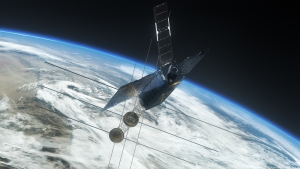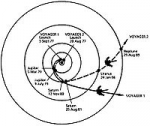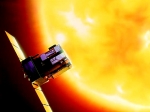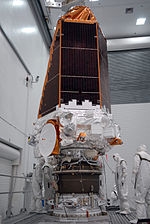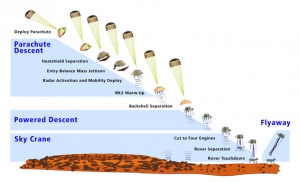Displaying items by tag: mission
THE NEXT GENERATION OF MARITIME COMMUNICATIONS
AAC Clyde Space AB, SAAB AB and ORBCOMM Inc. have today announced the development of the next generation of space based VDES system, marking the beginning of a new era in maritime communications. AAC Clyde Space AB will receive 17.0 MSEK in total, of which 12.2 MSEK is in the form of a grant from the Swedish Transport Administration, to finance the building, launch and commissioning of the first satellite in the project. This is intended to be the first satellite of a future constellation to provide a VDES service.
Orbit Logic Inc.
Orbit Logic is proposing mission planning and scheduling solutions.
Orbit Logic's operationally proven COTS products - STK Scheduler, Collection Planning & Analysis Workstation (CPAW), Collection Feasibility Tool (CFT), UAV Planner, and Sibyl Satellite Tasking mobile app - demonstrate Orbit Logic's expertise in aerospace planning and scheduling across a variety of platforms and domains.
Orbit Logic services enhance its mission planning and scheduling software. Services include mission specific software product configuration, product integration, program specific algorithm development and tuning, custom user interface and report development, process flow customization, project specific add-ons and new feature development, mission planning consulting and analysis, operations concept definition, automation refinement, and scheduling scenario development.
Discovery program
NASA's Discovery Program (as compared to New Frontiers, Explorers, or Flagship Programs) is a series of lower-cost, highly-focused American scientific space missions that are exploring the Solar System. It was founded in 1992 to implement then-NASA Administrator Daniel S. Goldin's vision of "faster, better, cheaper" planetary missions. Discovery missions differ from traditional NASA missions where targets and objectives are pre-specified. Instead, these cost-capped missions are proposed and led by a scientist called the Principal Investigator (PI). Proposing teams may include people from industry, small businesses, government laboratories, and universities. Proposals are selected through a competitive peer review process. All of the completed Discovery missions are accomplishing ground-breaking science and adding significantly to the body of knowledge about the Solar System.
NASA also accepts proposals for competitively selected Discovery Program Missions of Opportunity. This provides opportunities to participate in non-NASA missions by providing funding for a science instrument or hardware components of a science instrument or to re-purpose an existing NASA spacecraft. These opportunities are currently offered through NASA's Stand Alone Mission of Opportunity program.
Voyager program
The Voyager program is a U.S program that launched two unmanned space missions, scientific probes Voyager 1 and Voyager 2. They were launched in 1977 to take advantage of a favorable planetary alignment of the late 1970s.
Although officially designated to study just Jupiter and Saturn, the probes were able to continue their mission into the outer solar system, and are as of December 2011 on course to exit the solar system. These probes were built at JPL and were funded by NASA. Voyager 1 is currently the farthest human-made object from Earth.
Both missions have gathered large amounts of data about the gas giants of the solar system, of which little was previously known. In addition, the spacecraft trajectories have been used to place limits on the existence of a hypothetical trans-Plutonian Planet X.
SOHO (mission & spacecraft)
The Solar and Heliospheric Observatory (SOHO) mission purpose is to study the Sun from a point of gravitational balance.
The SOHO spacecraft has been built by a European industrial consortium led by Matra Marconi Space (now Astrium) that was launched on a Lockheed MartinAtlas IIAS launch vehicle on December 2, 1995 to study the Sun, and has discovered over 2100 comets. It began normal operations in May 1996.
It is a joint project of international cooperation between the European Space Agency (ESA) and NASA. Originally planned as a two-year mission,SOHO currently continues to operate after over fifteen years in space. In October 2009, a mission extension lasting until December 2012 was approved.
In addition to its scientific mission, it is currently the main source of near-real time solar data for space weather prediction. Along with the GGS Wind and Advanced Composition Explorer (ACE),SOHO is one of three spacecraft currently in the vicinity of the Earth-Sun L1 point, a point of gravitational balance located approximately 0.99 astronomical unit (AU)s from the Sun and 0.01 AU from the Earth. In addition to its scientific contributions, SOHO is distinguished by being the first three-axis-stabilized spacecraft to use its reaction wheels as a kind of virtual gyroscope; the technique was adopted after an on-board emergency in 1998 that nearly resulted in the loss of the spacecraft.
Kepler (mission & spacecraft)
The Kepler spacecraft is an American space observatory, the space-based portion of NASA's Kepler mission to discover Earth-like planets orbiting other stars. The spacecraft is named in honor of the 17th-century German astronomer Johannes Kepler. The spacecraft was launched on March 7, 2009, with a planned mission lifetime of at least 3.5 years.
The Kepler mission is "specifically designed to survey a portion of our region of theMilky Way galaxy to discover dozens of Earth-size planets in or near the habitable zone and determine how many of the billions of stars in our galaxy have such planets." Kepler's only instrument is a photometer that continuously monitors the brightness of over 145,000 main sequence stars in a fixed field of view. This data isanalyzed to detect periodic fluctuations that indicate the presence of extrasolar planets that are in the process of crossing the face of other stars.
The MSL mission (Mars Science Laboratory)
The Mars Science Laboratory (MSL) is a National Aeronautics and Space Administration (NASA) mission with the aim to land and operate a rover named Curiosity on the surface of Mars.
The MSL was launched November 26, 2011 at 10:02 am EST and will land on Mars at Gale Craterbetween August 6 and August 20, 2012. It will attempt to perform the first-ever precision landing on Mars. The rover Curiosity will help assess Mars' habitability, that is, whether Mars is, or ever was an environment able to support microbial life. It will also analyze samples scooped up from the soil and drilled powders from rocks.

